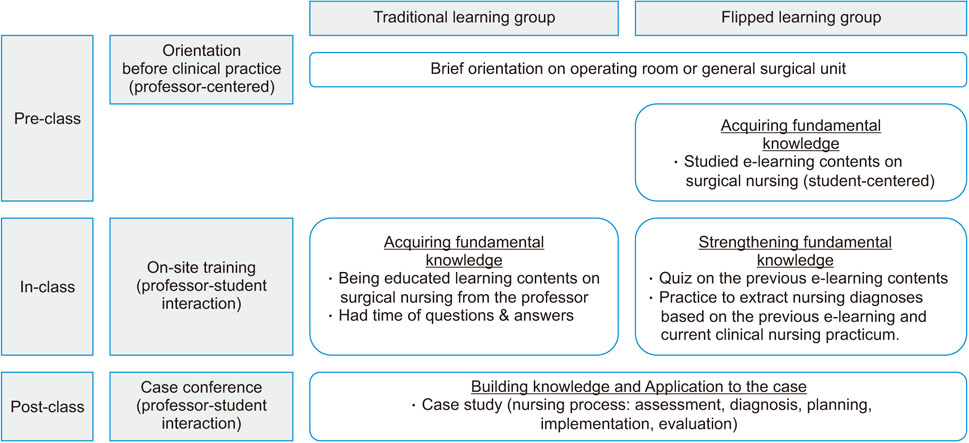Healthc Inform Res.
2018 Jan;24(1):69-78. 10.4258/hir.2018.24.1.69.
Effects of Flipped Learning Using Online Materials in a Surgical Nursing Practicum: A Pilot Stratified Group-Randomized Trial
- Affiliations
-
- 1College of Nursing and Research Institute of Nursing Science, Kyungpook National University, Daegu, Korea. bukpark@knu.ac.kr
- KMID: 2403298
- DOI: http://doi.org/10.4258/hir.2018.24.1.69
Abstract
OBJECTIVES
This study examined the effect of flipped learning in comparison to traditional learning in a surgical nursing practicum.
METHODS
The subjects of this study were 102 nursing students in their third year of university who were scheduled to complete a clinical nursing practicum in an operating room or surgical unit. Participants were randomly assigned to either a flipped learning group (n = 51) or a traditional learning group (n = 51) for the 1-week, 45-hour clinical nursing practicum. The flipped-learning group completed independent e-learning lessons on surgical nursing and received a brief orientation prior to the commencement of the practicum, while the traditional-learning group received a face-to-face orientation and on-site instruction. After the completion of the practicum, both groups completed a case study and a conference. The student's self-efficacy, self-leadership, and problem-solving skills in clinical practice were measured both before and after the one-week surgical nursing practicum.
RESULTS
Participants' independent goal setting and evaluation of beliefs and assumptions for the subscales of self-leadership and problem-solving skills were compared for the flipped learning group and the traditional learning group. The results showed greater improvement on these indicators for the flipped learning group in comparison to the traditional learning group.
CONCLUSIONS
The flipped learning method might offer more effective e-learning opportunities in terms of self-leadership and problem-solving than the traditional learning method in surgical nursing practicums.
MeSH Terms
Figure
Reference
-
1. Kim MK, Kim SM, Khera O, Getman J. The experience of three flipped classrooms in an urban university: an exploration of design principles. Internet High Educ. 2014; 22:37–50.
Article2. Christiansen MA, Nadelson L, Etchberger L, Cuch M, Kingsford TA, Woodward LO. Flipped learning in synchronously-delivered, geographically-dispersed general chemistry classrooms. J Chem Educ. 2017; 94(5):662–667.
Article3. Rossi RD. ConfChem conference on flipped classroom: improving student engagement in organic chemistry using the inverted classroom model. J Chem Educ. 2015; 92(9):1577–1579.
Article4. Tolks D, Schafer C, Raupach T, Kruse L, Sarikas A, Gerhardt-Szep S, et al. An introduction to the inverted/flipped classroom model in education and advanced training in medicine and in the healthcare professions. GMS J Med Educ. 2016; 33(3):Doc46.5. Davies RS, Dean DL, Ball N. Flipping the classroom and instructional technology integration in a college-level information systems spreadsheet course. Educ Technol Res Dev. 2013; 61(4):563–580.
Article6. Bergmann J, Sams A. Flip your classroom: reach every student in every class every day. Arlington (VA): International Society for Technology in Education;2012.7. Strayer JF. How learning in an inverted classroom influences cooperation, innovation and task orientation. Learn Environ Res. 2012; 15(2):171–193.
Article8. Presti CR. The Flipped learning approach in nursing education: a literature review. J Nurs Educ. 2016; 55(5):252–257.
Article9. Njie-Carr VP, Ludeman E, Lee MC, Dordunoo D, Trocky NM, Jenkins LS. An integrative review of flipped classroom teaching models in nursing education. J Prof Nurs. 2017; 33(2):133–144.
Article10. Cheraghi F, Hassani P, Yaghmaei F, Alavi-Majed H. Developing a valid and reliable Self-Efficacy in Clinical Performance scale. Int Nurs Rev. 2009; 56(2):214–221.
Article11. Stewart GL, Courtright SH, Manz CC. Self-leadership: a multilevel review. J Manag. 2011; 37(1):185–222.
Article12. Houghton JD, Neck CP. The revised self-leadership questionnaire: testing a hierarchical factor structure for self-leadership. J Manag Psychol. 2002; 17(8):672–691.13. D'Zurilla TJ, Nezu AM, Maydeu-Olivares A. Problem-solving Inventory Revised (SPSI-R). North Tonawanda (NY): Multi-Health Systems;2002.14. Beaton DE, Bombardier C, Guillemin F, Ferraz MB. Guidelines for the process of cross-cultural adaptation of self-report measures. Spine (Phila Pa 1976). 2000; 25(24):3186–3191.
Article15. Burke SM. Cultivating critical thinking using virtual interactive case studies. J Pediatr Nurs. 2017; 33:94–96.
Article16. Choi J, Kim EG. Developing a teaching-learning model for flipped learning for institutes of technology and a case of operation of a subject. J Eng Educ Res. 2015; 18(2):77–88.
Article17. Martyn J, Terwijn R, Kek MY, Huijser H. Exploring the relationships between teaching, approaches to learning and critical thinking in a problem-based learning foundation nursing course. Nurse Educ Today. 2014; 34(5):829–835.
Article18. Park EO, Park JH. Quasi-experimental study on the effectiveness of a flipped classroom for teaching adult health nursing. Jpn J Nurs Sci. 2017; Aug. 18. [Epub]. DOI: 10.1111/jjns.12176.
Article19. Kim HS, Kim MY, Cho MK, Jang SJ. Effectiveness of applying flipped learning to clinical nursing practicums for nursing students in Korea: a randomized controlled trial. Int J Nurs Pract. 2017; 23(5):e12574.
Article20. El-Banna MM, Whitlow M, McNelis AM. Flipping around the classroom: accelerated Bachelor of Science in Nursing students' satisfaction and achievement. Nurse Educ Today. 2017; 56:41–46.
Article21. Kim H, Jang Y. Flipped learning with simulation in undergraduate nursing education. J Nurs Educ. 2017; 56(6):329–336.
Article22. Lee MK. Effects of mobile phone-based app learning compared to computer-based web learning on nursing students: pilot randomized controlled trial. Healthc Inform Res. 2015; 21(2):125–133.
Article23. Barak M, Rafaeli S. On-line question-posing and peerassessment as means for web-based knowledge sharing in learning. Int J Hum Comput Stud. 2004; 61(1):84–103.
Article
- Full Text Links
- Actions
-
Cited
- CITED
-
- Close
- Share
- Similar articles
-
- Effects of the Flipped Classroom Approach on the Psychiatric Nursing Practicum Course
- Effects of Flipped Learning on the Critical Thinking Disposition, Academic Achievement and Academic Self-efficacy of Nursing Students: A Mixed Methods Study
- The effect of case-based learning based on flipped learning for nursing students
- Effect of flipped learning-based smoking cessation intervention education program for nursing students in South Korea
- The Effect of the Flipped Learning on Self-efficacy, Critical Thinking Disposition, and Communication Competence of Nursing Students


